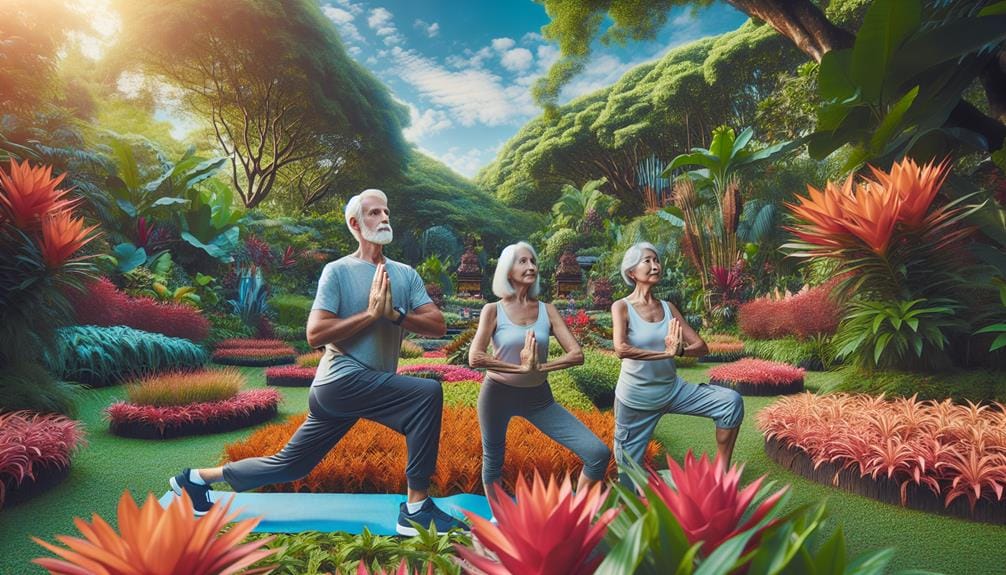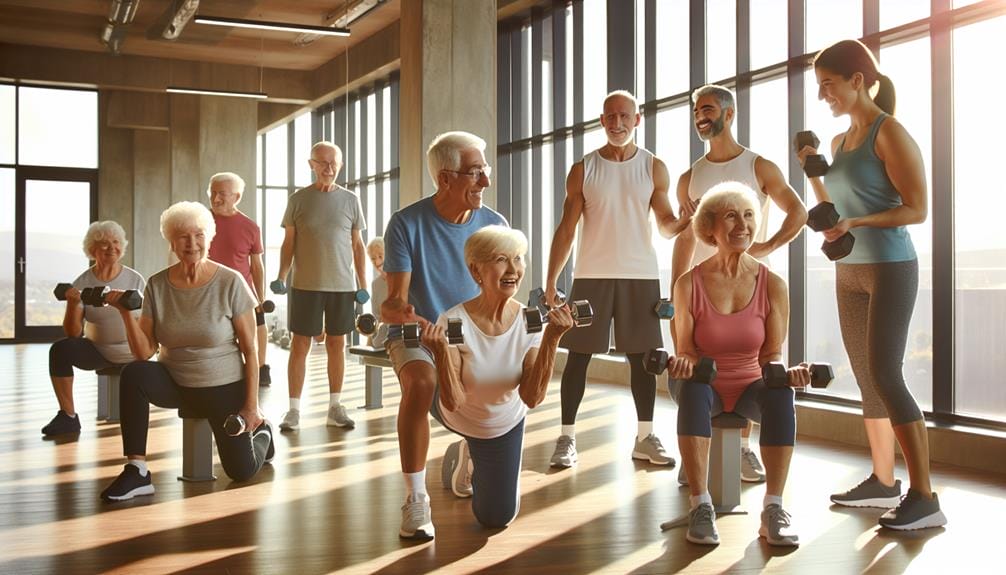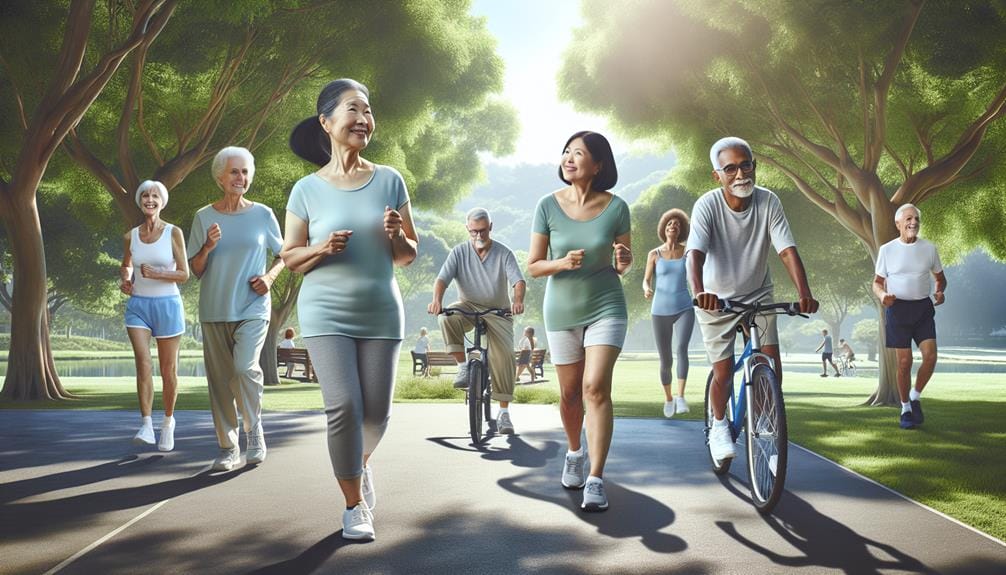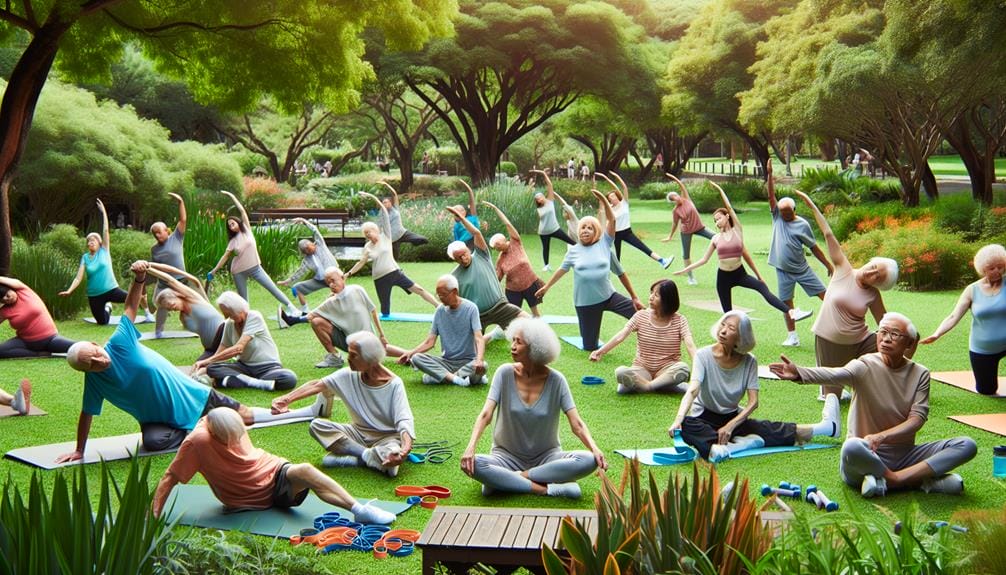Staying active is essential for seniors to maintain health and well-being. Aim for at least 150 minutes of moderate exercise weekly, like walking or swimming. Incorporate strength training on two or more days to build muscle and boost strength. Balance exercises, such as ankle circles and heel-to-toe walking, performed three times weekly can reduce fall risks. Remember, balancing exercise with 2-3 rest days prevents overexertion and promotes muscle recovery. Consistency in your routine is key. Exploring a variety of physical activities suited to your abilities will enhance your fitness and overall health. Discover more tips for staying active and healthy.
Key Takeaways
- Engage in 150 minutes of moderate-intensity exercise weekly to boost overall health.
- Incorporate muscle-strengthening activities at least two days a week to enhance strength.
- Perform balance exercises three times weekly to reduce fall risks and improve stability.
- Include a variety of exercises based on individual abilities to keep routines enjoyable and effective.
- Balance exercise days with 2-3 rest days per week to prevent injury and maintain energy levels.
Health Benefits of Exercise
Engaging in regular exercise improves balance, flexibility, and strength, greatly reducing your risk of falls and injuries. Think of it as a triple threat against gravity's evil plan to trip you up.
For older adults, the health benefits of exercise go beyond just staying upright. Physical activity, including balance exercises and flexibility exercises, can help manage chronic conditions like heart disease and diabetes.
Adding some strength training to your routine can make you feel like a superhero, minus the cape (unless capes are your thing).
Recommended Exercise Frequency

You should aim to engage in at least 150 minutes of moderate exercise each week, as recommended by health experts.
Incorporate muscle-strengthening activities on two or more days and balance exercises three times a week to maximize health benefits.
Remember to balance exercise days with rest periods to allow your body to recover and stay strong.
Optimal Weekly Routine
For ideal health, seniors should aim for at least 150 minutes of moderate-intensity exercise each week. Wondering how to fit that in without turning into a gym rat? Here's a simple plan:
- Engage in muscle-strengthening activities at least two days a week. Think lifting light weights or even grandkids (with caution!).
- Perform balance exercises three times a week to keep you steady on your feet and avoid those not-so-graceful falls.
- Include a variety of physical activities based on your abilities, even if you have chronic conditions.
Consistency is key! A regular, enjoyable routine will do wonders for your well-being, so mix it up and keep it fun. Your body (and maybe your dance moves) will thank you!
Balancing Rest Days
While maintaining a consistent exercise routine is important, it's equally vital to balance it with proper rest days to guarantee your body recovers and stays strong.
Seniors, you don't want to overtrain and end up feeling like a rusty old tin man, do you? Aim for 2-3 rest days per week to prevent injury and muscle fatigue.
These rest days are your secret weapon to improving exercise performance and enjoying long-term health benefits. Balancing rest days with active exercise keeps your muscles happy and your energy levels up.
Balance Exercises
Balance exercises are essential for maintaining stability and reducing the risk of falls in seniors. You can incorporate simple techniques like standing on one leg or walking heel-to-toe, which require no equipment.
Simple Balance Techniques
Incorporating simple balance techniques into your routine can greatly enhance your stability and reduce the risk of falls. Regularly practicing balance exercises is essential for older adults to improve stability and maintain mobility.
Here are some fun and simple techniques:
- Ankle circles: Rotate your ankles in both directions to improve flexibility.
- Hip rotations: Gently circle your hips to keep them limber.
- Walking heel-to-toe: Walk in a straight line, placing the heel of one foot directly in front of the toes of the other, to challenge your balance.
These exercises not only help reduce falls but also boost your independence. Plus, who doesn't want an excuse to walk like a tightrope artist in their living room?
Equipment-Free Stability Drills
You don't need any fancy equipment to perform effective stability drills that enhance your balance and reduce the risk of falls. In fact, these equipment-free balance exercises are perfect for seniors looking to improve balance and prevent falls without leaving the comfort of home.
Think of it as a workout for your inner tightrope walker—minus the actual tightrope.
Balance exercises like standing on one leg or walking heel-to-toe can strengthen muscles, boost stability, and make you feel like a ninja. Just don't try to do any backflips, okay?
Consistent practice of these stability drills will have you feeling more coordinated and confident in no time. So go ahead, give it a try, and embrace your inner balance master!
Daily Balance Routines
Start your day with simple balance exercises like walking heel-to-toe or practicing standing from a sitting position to boost your stability and coordination. These exercises are essential for seniors to maintain mobility and prevent falls, which can drastically impact your independence and quality of life. Consistency is key, so aim to do these exercises at least three times a week.
- Walk heel-to-toe: This helps improve your balance and coordination.
- Use a wobble board: It can challenge your stability in a fun way.
- Neck stretches and shoulder rolls: Keep your upper body flexible.
Strength Training

Engaging in consistent strength training can greatly enhance muscle mass, bone density, and overall strength for seniors. You might be thinking, 'I'm too old for this!', but trust us, it's never too late to start pumping iron.
Strength training for older adults can improve balance and reduce the risk of falls—think of it as your secret weapon against gravity. By building muscle mass and boosting functional abilities, you're not just lifting weights; you're lifting your quality of life and independence.
Plus, with just 2-3 sessions a week, you'll be flexing those biceps and feeling stronger in no time. So, grab those dumbbells and show Father Time who's boss!
Low Impact Activities

Low-impact activities like swimming and cycling offer a gentle yet effective way to improve cardiovascular health without stressing the joints. Not only are these activities easy on your body, but they also pack a punch in keeping you active and strong.
- Water aerobics: Perfect for enhancing balance and flexibility while giving you an excuse to splash around.
- Chair exercises: Boost muscle strength without the risk of falling over. You can even do them while watching TV!
- Walking: A low-impact exercise that fits seamlessly into your daily routine. Plus, you can wave at your neighbors like the local celebrity you are.
Cardiovascular Workouts

Incorporating cardiovascular workouts into your routine can greatly enhance heart health and overall endurance. For seniors, activities like brisk walking, swimming, and dancing can turn you into a cardio king or queen, without the royal aches.
Aerobic exercise, like water aerobics or low-impact aerobics, keeps your heart pumping and your mood soaring. Plus, you'll have a great excuse to don that stylish swim cap!
Aim for 150 minutes of moderate-intensity aerobic exercise each week to boost cardiovascular fitness and reduce the risk of heart disease and stroke. Regular cardio workouts can also help maintain healthy blood pressure and cholesterol levels.
Mobility and Flexibility Exercises

Mobility and flexibility exercises, like ankle rotations and shoulder rolls, can greatly enhance your range of motion and prevent injuries. These exercises are essential for improving joint mobility and maintaining better posture. By incorporating them into your daily routine, you'll not only reduce the risk of injury but also enhance overall mobility.
Try these simple yet effective moves:
- Ankle circles: Perfect for improving ankle flexibility and stability.
- Seated leg lifts: Great for enhancing lower body strength and joint range of motion.
- Shoulder blade squeezes: Ideal for better posture and reducing shoulder tension.
Conclusion
So, you think you're too old to exercise? Think again. Staying active through balance exercises, strength training, low impact activities, cardiovascular workouts, and mobility routines isn't just for the young.
It's ironic, but the more you move, the healthier you'll be. Exercise helps you maintain independence, improves your mood, and keeps those pesky health issues at bay.
So, lace up those sneakers and get moving; your future self will thank you.






Leave a Comment